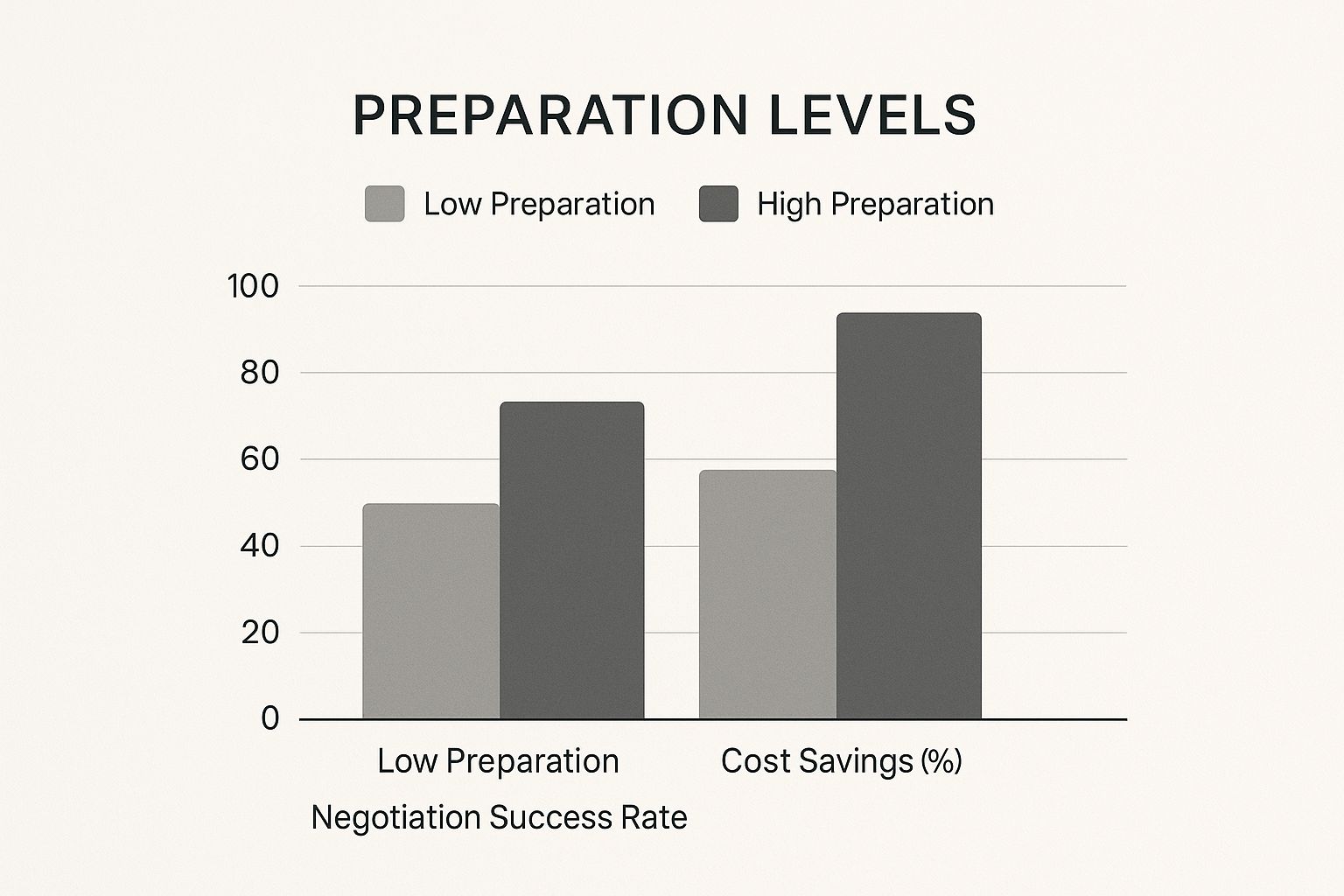
Reading Financial Reports for Dummies: Step-by-Step Guide
September 15, 2025
Accountants Near Auckland Airport
September 24, 2025Why Mastering Supplier Negotiation Transforms Your Bottom Line

Many businesses miss out on savings during supplier negotiations. It’s not about being aggressive, but about understanding effective negotiation strategies. This means creating agreements that benefit both sides. Mastering this skill has a direct impact on your bottom line, operational efficiency, and even how you compete in the market. Skilled negotiators don’t just get 10-15% better terms; they build stronger relationships with their vendors.
It’s important to shift from simply wanting the lowest price to creating value. A “lowest price wins” approach can actually hurt you in the long run. Focusing only on price can damage relationships, leading to lower quality products and problems with deliveries. Strategic negotiation, on the other hand, builds partnerships. It turns one-time deals into long-term collaborations.
The Real Financial Impact of Negotiation
Negotiation is about more than just getting a good deal today; it’s about building a sustainable advantage for the future. Securing better payment terms, for example, can greatly improve your cash flow. This frees up resources for investment and growth. Negotiating longer contracts with dependable suppliers stabilizes your supply chain. This helps avoid disruptions and ensures consistent quality.
Beyond Price: Unlocking Hidden Value
Effective negotiation also unlocks value beyond the initial price. Think about factors like these:
- Faster Delivery Times: Negotiating shorter lead times makes your operations smoother and improves customer satisfaction.
- Improved Quality Control: Working with suppliers on stricter quality standards can lead to fewer defects and returns.
- Value-Added Services: Explore if suppliers can provide extra services like training, maintenance, or even joint marketing efforts.
These non-price factors significantly impact your overall profitability and competitive edge. They help build a more resilient and efficient business model. By focusing on these long-term benefits, supplier negotiation becomes a strategic driver of growth. This allows you to create stronger, more valuable partnerships that contribute to your long-term success.
The Preparation Playbook: Setting the Stage for Success

Negotiations can often fall apart before they even start due to a lack of preparation. Think of it like a sports team: success requires a solid game plan. This means understanding both your own needs and the position of your supplier. This section outlines the essential steps to prepare for successful supplier negotiations, giving you a real advantage at the bargaining table.
Analyzing Your Spending and Supplier Costs
The first step is to take a close look at your spending. This means identifying your most important suppliers and what you’re paying them. Try categorizing your spending by product type, supplier, and how often you make purchases. This gives you a clear understanding of your leverage with each supplier. You should also research your supplier’s cost structure to understand how flexible they might be. This includes things like the cost of their raw materials, labor rates, and overhead expenses.
Defining Negotiation Parameters
Once you have a handle on your spending and the supplier’s costs, it’s time to set clear negotiation parameters. You’ll want to establish a target price, which is the best-case scenario you’re aiming for. This target should be ambitious but realistic, grounded in your research and an understanding of the current market. Just as important is setting a walkaway point. This is the point where you’re prepared to walk away from the deal. Knowing your limits keeps your team on the same page and prevents you from making concessions that break your budget or go against your core needs.
Before you head into negotiations, use this checklist to make sure you’re completely prepared. It covers everything from understanding your own needs to researching your supplier’s position.
Negotiation Preparation Checklist
| Preparation Task | Why It Matters | Completion Timeline |
|---|---|---|
| Analyze your spending | Identify key suppliers and associated costs | At least 2 weeks before negotiation |
| Research supplier costs | Understand supplier flexibility and potential discounts | 1 week before negotiation |
| Define target price | Set a realistic yet ambitious goal | Before negotiation begins |
| Determine walkaway point | Protect your budget and core needs | Before negotiation begins |
| Research supplier challenges | Identify leverage opportunities | 1 week before negotiation |
| Assemble your team | Ensure a coordinated approach | At least 1 week before negotiation |
| Define BATNA | Strengthen your team’s position | Before negotiation begins |
This checklist helps ensure you’ve covered all the bases, giving you the confidence and preparation needed to negotiate effectively. By completing these steps, you’ll be well-positioned to achieve a favorable outcome.
Researching Supplier Challenges and Opportunities
Knowing your supplier’s challenges and pressure points can create opportunities for leverage. This might involve researching their financial performance, market share, and who they compete with. For example, a supplier with declining sales may be more open to negotiating favorable terms to secure your business. By understanding their needs and challenges, you can create a more advantageous position for yourself during negotiations.
Assembling and Preparing Your Negotiation Team
Negotiation is often a team effort. Choose team members with the right skills and experience for different parts of the discussion. Assign clear roles and responsibilities to each member to make sure everyone’s coordinated. For example, one person might focus on pricing while another handles logistics or contract terms. A structured approach like this minimizes confusion and keeps the negotiation efficient. Also, having a clear understanding of your BATNA (Best Alternative To a Negotiated Agreement) strengthens your team’s position.
Having a well-defined preparation process changes negotiation from a stressful task into a strategic opportunity. It allows you to enter discussions confidently and get better results. With careful planning and execution, you can build stronger supplier relationships and maximize value for your business.
Leveraging Regional Economic Trends for Stronger Positions

Global economic forces have a significant impact on supplier negotiations. They offer hidden leverage that many procurement teams miss. Savvy negotiators understand how to monitor and use these regional economic indicators. This allows them to perfectly time their discussions and secure better terms. This section explains how you can use these powerful insights to improve your negotiation outcomes.
Tracking Economic Indicators
By tracking key economic indicators, you can anticipate shifts in supplier dynamics. For example, closely monitor labor costs in your supplier’s region. Increases in labor costs can squeeze a supplier’s margins, making them more open to negotiations on pricing or other terms. This creates an opportunity for you to secure more favorable agreements.
Also, pay attention to trends in raw material prices. If the cost of key materials is decreasing, you can use this information to negotiate lower prices for the goods you purchase.
Currency fluctuations can also significantly impact your supplier’s profitability. If your currency strengthens against the supplier’s currency, you gain immediate purchasing power. Use this to your advantage during supplier negotiations.
This added leverage lets you push for better pricing or other concessions. For example, if the New Zealand dollar strengthens against the US dollar, businesses in Auckland can secure better deals from US suppliers.
Global economic shifts and regional market fluctuations are increasingly influencing the dynamics of supplier negotiations.
Building Economic Trigger Clauses
Forward-thinking procurement teams build economic trigger clauses into their contracts. These clauses automatically adjust terms when pre-defined economic conditions change. For example, a contract could include a clause stating that the price will be renegotiated if raw material costs increase by a certain percentage.
This protects both parties from unexpected market volatility. These clauses provide a way to manage risk and maintain a stable, predictable relationship with your suppliers.
Addressing Supply Chain Disruptions and Tariffs
Economic instability can also lead to supply chain disruptions. Savvy negotiators proactively develop strategies to address these potential problems. For example, they might diversify their supplier base to reduce their reliance on any single source.
They might also negotiate longer-term contracts with key suppliers to secure supply during periods of uncertainty. Changes in tariffs can also significantly affect the cost of goods. Understanding these changes allows you to adjust your negotiation strategy accordingly.
Turning Disruptions into Opportunities
By closely monitoring regional economies, procurement teams can turn potential disruptions into opportunities. For example, if a supplier in one region is facing economic hardship, you may be able to negotiate extremely favorable terms.
However, it’s important to maintain a collaborative approach. A win-win strategy will strengthen your long-term relationship, even during challenging times. By understanding these complexities, you can navigate the global marketplace more effectively and build stronger, more resilient supplier relationships.

The infographic above shows how preparation impacts both negotiation success and potential cost savings. Better preparation leads to higher success rates and bigger savings. This highlights the importance of investing time and resources in thorough preparation before talking with suppliers. Technology is also playing a key role in improving the entire negotiation process, from planning to execution.
Communication Tactics That Disarm and Persuade
Effective negotiation depends on strong communication. It’s more than just stating your needs. It’s about understanding how persuasion works and building a good relationship with your supplier. This means actively listening, asking smart questions, and presenting your proposals in a way that connects with them.
Reading Between the Lines: Verbal and Nonverbal Cues
Suppliers might say they’re inflexible, but small clues can reveal hidden flexibility. Pay attention to their verbal cues. Things like hesitations, qualifying language (“That might be difficult”), or indirect responses can indicate there’s room for negotiation.
Body language is also important. Notice their posture, eye contact, and facial expressions. Are they leaning in and engaged, or are they leaning back and resistant? These nonverbal signals can give you valuable insights into their real position.
Strategic Questioning: Uncovering Supplier Motivations
Asking the right questions is crucial. Instead of just stating your demands, ask open-ended questions to understand your supplier’s motivations and limitations. Try questions like “What are your biggest challenges right now?” or “What are your priorities for this partnership?” You can then use these insights to find solutions that benefit both of you.
Don’t reveal your own position too early. Focus on understanding theirs first. This gives you the information you need to tailor your proposals to their specific needs.
Framing Proposals for Maximum Appeal
How you present your terms makes a big difference. Frame your proposals to highlight the benefits for both sides. Instead of focusing only on price, emphasize the value you offer. This might include guaranteed volume commitments, the potential for a long-term partnership, or co-marketing opportunities.
Showing how your terms contribute to their success makes your offer more attractive. This collaborative approach increases the likelihood of reaching an agreement that works for everyone.
Overcoming Deadlocks and Navigating Difficult Conversations
Negotiations don’t always go as planned. Be ready for deadlocks and difficult conversations. If things get stuck, reiterate shared goals and interests. This reminds everyone of the bigger picture and encourages them to find common ground.
Having response templates ready for common objections and counteroffers can be helpful. These pre-planned responses help you stay calm and in control during tough conversations.
Managing Cultural Differences in International Negotiations
International negotiations add another layer of complexity. Cultural differences in communication styles and decision-making can have a big impact. Researching your supplier’s cultural background can prevent misunderstandings and help you build a relationship. For example, some cultures make decisions collectively, while in others, one person has the final say.
Understanding these differences is important for navigating cross-cultural negotiations. Adapting your approach based on cultural context can strengthen relationships and lead to better outcomes. This includes being aware of how different cultures view time, direct communication, and the importance of relationships.
Transforming Negotiations into Strategic Partnerships
The most effective negotiators understand that a successful deal involves more than just the initial agreement. It’s about building a strategic partnership that creates value over time. This section explores how to find the right balance between short-term gains and long-term relationship building.
You might be interested in: How to master business growth strategies.
Structuring Agreements for Mutual Benefit
Top organizations create agreements that encourage suppliers to consistently deliver greater value. This means going beyond just setting a price. It involves incorporating performance-based terms and shared success metrics.
Additionally, consider implementing shared success metrics. This means that when your business achieves certain goals, the supplier also benefits. This fosters a true partnership where both parties are invested in each other’s success. This could involve sharing a percentage of increased revenue or offering volume discounts tied to sales growth.
Collaborative Improvement and Risk Sharing
Moving past transactional agreements requires fostering collaborative improvement. This means working together to find areas where both parties can optimize processes and reduce costs.
This might involve sharing best practices, investing in joint training, or developing new technologies together.
Further strengthening these partnerships involves using risk-sharing mechanisms. This means that if unexpected events affect the business, both parties share the burden. This might include agreeing on price adjustments based on changes in raw material costs or sharing the cost of disruptions in the supply chain. This approach builds trust and creates a more resilient partnership. Open communication is vital for successful negotiations. Check out this practical guide on How to Overcome Communication Barriers.
Supplier Relationship Management: From Transactional to Transformational
Formal supplier relationship management (SRM) programs can change how businesses interact with suppliers. These programs provide a structured way to manage supplier relationships, incorporating regular reviews and joint problem-solving frameworks.
Regular meetings provide a space for discussing performance, identifying potential problems, and collaborating on solutions. Joint problem-solving frameworks ensure that challenges are addressed proactively and constructively.
This approach shifts transactional relationships into true partnerships. This opens up opportunities for clear communication, shared goals, and a focus on mutual benefit.
Case Studies: Real-World Examples of Strategic Partnerships
Many organizations have successfully used these strategies to achieve significant results. For instance, some companies have negotiated preferred access to supplies during shortages. This safeguards them from supply chain issues and ensures business continuity. Other companies have partnered with suppliers on product development, resulting in innovative products that give them a market advantage.
These real-world examples highlight the effectiveness of strategic supplier relationships. They show how a collaborative approach can create competitive advantages and drive long-term success.
Are you ready to take your supplier negotiations to the next level and unlock more value for your business? Learn how Business Like NZ Ltd can help you develop and implement these effective strategies. Visit us at https://businesslike.co.nz.




